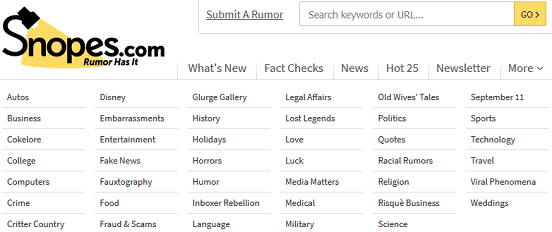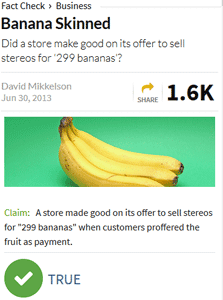

In a Nutshell: While rumor has always moved swiftly from person to person, the digital era and its ability to instantly communicate every thought, whisper, and rumor, has made distinguishing fact from fiction infinitely more difficult. For millions of people, the solution to identifying fake news and false reports is Snopes.com, a leading fact-finding website that’s been around since 1994. The team at Snopes investigates the latest news, urban myths, and cultural legends to find the true story. Covering topics from business and fraud to entertainment and sports, Snopes can help defeat the scammers in your inbox asking for money and fraudsters on your phone trying to con you out of your credit. Don’t fall for a fake story — “Snopesify” it instead.
We all know the classic legends and urban myths that have become interwoven into our cultures, some even across continents and societies, such as Bigfoot or the Loch Ness Monster. And, of course, most have heard the conspiracy theories that may be totally responsible for holding up the internet (like the extraterrestrials housed in Area 51, and the “faked” Moon landing).
Many of these prevalent ideas have lived for decades in the minds and imaginations of hundreds of thousands of people around the world. As is our nature, though, new tales are constantly being told, new stories created, and new adventures imagined that cause the collection of myths to continuously grow — for better, or for worse.
David Mikkelson and his team at Snopes.com have made it their job to prune the growing patch of myths as they sprout, helping the average consumer sort through the nonsense to find the truth. In fact, Snopes has been a leading source for fact-checking on the internet almost as long as there has been an internet, debunking legends on the infant World Wide Web in 1994.
“I was on the internet before most people were aware there was an internet,” described David. “I was on text-based discussion groups talking about urban legends; so, when the Web came along, I started writing up a collection of Disney-related legends and other categories.” Before long, David was flooded with questions and emails from a growing digital audience.
“It took a left turn and became the place where everybody started sending stuff to find out, [such as the veracity of] things they were getting in their e-mail, [asking] is this true or not,” David said. “So it spread to hoaxes and scams and missing kids and fake photos. It took a surprisingly long time, but eventually, politics became a thing.”
Nowadays, Snopes.com helps millions of users a month tell fake news from real reporting, find the facts behind the email scams in their inboxes, and get the truth about — well, just about everything. In fact, Snopes has even become its own verb; unsure about the validity of a story? Better “Snopesify” it.
Debunking the Legends and Quashing Modern Tall Tales through Extensive, In-Depth Research
When David started the site more than 20 years ago, fact-finding involved a lot of legwork. Today, he said, most of the research can be done online, but that doesn’t mean they put in any less effort. With so much false information floating around the internet, it takes a combination of hard word and good old fashioned experience to sort it all out. Of course, one thing that hasn’t changed over the last two decades? The abundance of stories that need the Snopes treatment.
“Technology changes, but human nature doesn’t,” said David. “People want to believe the same things for the same reasons, and spread the same kind of stories. It’s just, instead of talking over their back fence, they’re on Facebook or whatever, and it’s still the same function.”

You can use Snopes to get the facts on a variety of myths and legends across dozens of categories, from business and fraud to travel and politics.
Indeed, you can find a huge variety of myths and scams in the pages of Snopes, some new, some just variations of classic scams and stories, and covering all manner of topics. From unbelievable tales about automobiles to questionable wedding woes — and dozens of categories in between — Snopes covers whatever people need to know.
“We’ve always stuck to what most people are asking about, talking about,” David explained. “It used to be easy in the days before social media. We could just look at our e-mail, and that’s pretty much how everything was disseminated. But now, with social media and sites like Reddit, it’s more diffused. I don’t think there’s any scientific method to it.”
Saving Consumers from Financial Frauds and Potentially Perilous Purchases
While there may be some bias on my part, I think one of the most important services Snopes offers its readers is the ability to save themselves — and their pocketbooks — from an expensive scam. Remember the infamous Nigerian Prince who emailed asking for your help? Well, he’s still around — and he’s not alone.

Snopes helps millions of readers identify fraudulent claims and email scams.
“Too much of what ends up in our inboxes these days are scams: dishonest attempts to separate us from our money,” states the site’s Scams page, a color-coded list of popular scams the site has proved or debunked over the years. The stories addressed include email chains and telephone frauds, such as a series of swindlers posing as IRS workers to collect personal information.
Many of the money myths addressed by Snopes seem to have one thing in common: they all sound too good to be true. Who doesn’t want to make a $1,000 for cashing a check? And all your problems can be solved if you just claim your foreign lottery winnings! According to David, sometimes all it takes to fool someone out of their funds — is inserting some statistics.
“[Urban myths] generally speak to something that people already believe, or confirm something they want to believe. That’s kind of what people cling to,” he said. “There’s a lot of market for [articles in which] you just say something authoritatively and people will believe it. A lot of memes bank on that. It’s full of numbers or stats, [and people think], ‘How can you dispute this?'”
4 Bizarre Money Stories — That Turned Out to Be True
While browsing Snopes for a while may make it seem as though the business world is out to get you, not every story on Snopes is about sneaky thieves and fraudulent claims. A number of articles on the fact-finding site are about stories that have been proven true — regardless of how wacky some of them seem. Here are just a few of the strangest true money stories you’ll find on Snopes.com.
1. The Sound of 299 Bananas
In an important lesson on the importance of clear communication, the Snopes article Banana Skinned describes a story from 1986 about a chain of electronics stores that made an unfortunate choice in marketing language — and the consumers who went bananas over it.

Snopes found the story of a store trading stereos for bananas to actually be completely true.
The company, Silo, ran a television campaign advertising a popular stereo model for “299 bananas,” using a common slang term for “dollar bills.” Unfortunately for the electronics chain, however, a number of customers took them at their word.
According to the article, “Thirty-two customers held the retailer to its unwitting word — they showed up bearing loads of the yellow fruit and demanding the store keep its end of the bargain.” Proving the company had a sense of humor as well as customer service, Silo properly exchanged stereos for bananas, donating the fruit to a local zoo and food banks.
“Each stereo was exchanged for $40 to $60 worth of bananas, and Silo took in a total of 11,000 bananas,” states the article. “Many of the bananas were donated to Woodland Park Zoo, but there were too many even for the hungry animals.”
2. Educated Cents
In what may very well be one of the first individual crowd-funding campaigns, Snope’s Cent to College article tells the true tale of an ingenious undergraduate. In 1987, Mike Hayes was a chemistry freshman at the University of Illinois who was having trouble paying his tuition. In pre-tech Kickstarter fashion, Mike decided to fundraise the money he needed — one penny at a time — by soliciting the help of a popular newspaper columnist, Bob Greene.
“Just one penny,” Mike is quoted in the article. “A penny doesn’t mean anything to anyone. If everyone who is reading your column looks around the room right now, there will be a penny under the couch cushion, or on the corner of the desk, or on the floor. That’s all I’m asking. A penny from each of your readers.”
In what may be little surprise in light of today’s crowd-funded world, Mike’s campaign was a smashing success. According to Snopes, “In less than a month, the ‘Many Pennies for Mike’ fund was up to the equivalent of 2.3 million pennies. Not everyone was content to send merely a penny (hence the “equivalent” statement above) — many sent nickels, dimes, quarters and even more. There’s something lovable about a kid who asks you for a penny.”
3. A Plane Full of Pudding
Most anyone who travels regularly collects frequent flyer miles for their favorite airlines, eventually earning themselves discounted or even free flights. The internet abounds with stories of smart shoppers and credit card churners who accumulate hundreds of thousands of airlines miles, but few are quite as amazing as the Snopes article, Pudding on the Ritz, about David Phillips, an engineer who turned $3,150 of pudding into 1.2 million frequent flyer points.

One bizarre story confirmed by Snopes involved David Phillips, who earned more than 1.2 million airline miles — with the help of thousands of pudding cups.
“Last May, Phillips was pushing his shopping cart down the frozen-food aisle of his local supermarket,” states the article, “when a promotion on a Healthy Choice frozen entree caught his eye: He could earn 500 miles for every 10 Universal Product Codes (bar codes) from Healthy Choice products he sent to the company by Dec 31. Even better: Any Healthy Choice bar codes mailed by the end of the month would rack up double the mileage, or 1,000 miles for every 10 labels.”
For the math-savvy engineer, it didn’t take long to realize a good deal when he saw one — especially when it got even better. At his local warehouse store, he stumbled across $0.25 pudding cups that qualified for the promotion — and he promptly bought all of the pudding cups he could get his hands on.
“Phillips cleaned the store out – bought every last cup of pudding in the warehouse. He then asked the manager for the addresses of all the other Grocery Outlets in the Central Valley and, with his mother-in-law riding shotgun in his van, spent a weekend scouring the shelves of every store from Davis to Fresno,” said the article. “All in all, he’d purchased 12,150 individual servings of pudding.”
4. The Price of a Penny
A common myth that has been circulating for years focuses on the cost to create the one-cent coin, or penny — the lowest denomination of U.S. currency. The penny’s usefulness often comes up in conversation, especially questions concerning whether it actually costs more than one cent to manufacture a one-cent coin. Snopes explored the question in an article called, Making Cents. Everything from supply and demand of the metals used in production (zinc and copper), to general economic inflation has impacted the cost to make a cent — with the scale tipping in the wrong direction in 2006.
According to the article, “In 2005, the cost to the United States Mint to produce a penny was 0.97¢, which was just a smidge under a cent. In 2006, that year’s pennies each cost about 1.23¢ to manufacture. Increases in metal prices, particularly of zinc, pushed the per-unit cost up to 1.7¢ in 2007. By 2012, production costs had risen to 2.41¢ per penny.”
Don’t write to your senator just yet, however. The thing to keep in mind here is that the manufacturing cost only applies one time. As the Snopes article points out, “If pennies were used but once then thrown away, yes, of course, their costing American taxpayers 2.41¢ apiece would be a horrible, horrible thing. But, they’re not; pennies pass through hundreds, thousands, and maybe even millions of hands before they somehow drop out of circulation, which more than covers the additional 1.41¢ that went into their manufacture.”
Empty the Rumor Mill with Snopes.com
While it may be argued that there is little harm in a good legend (who doesn’t love a fun Bigfoot story?), when left unchecked, rumors can often spread faster than wildfire — and cause almost as much damage. From financial frauds in your inbox to fake news stories on your homepage, modern consumers often need a little help separating the fact from the faked.

For millions of users every month, that help comes from Snopes.com. So, the next time you get an email offering a quick way to make millions, don’t respond — “Snopesify” it.
Advertiser Disclosure
BadCredit.org is a free online resource that offers valuable content and comparison services to users. To keep this resource 100% free for users, we receive advertising compensation from the financial products listed on this page. Along with key review factors, this compensation may impact how and where products appear on the page (including, for example, the order in which they appear). BadCredit.org does not include listings for all financial products.
Our Editorial Review Policy
Our site is committed to publishing independent, accurate content guided by strict editorial guidelines. Before articles and reviews are published on our site, they undergo a thorough review process performed by a team of independent editors and subject-matter experts to ensure the content’s accuracy, timeliness, and impartiality. Our editorial team is separate and independent of our site’s advertisers, and the opinions they express on our site are their own. To read more about our team members and their editorial backgrounds, please visit our site’s About page.
